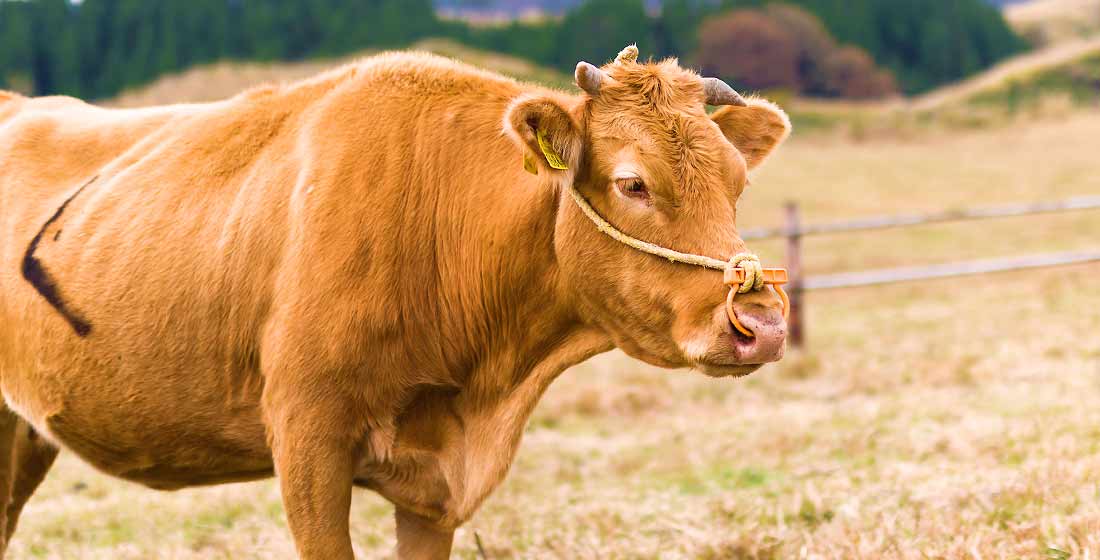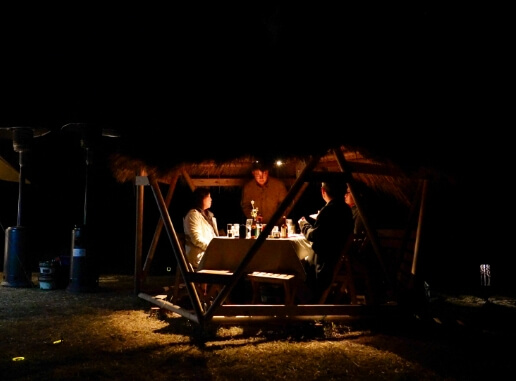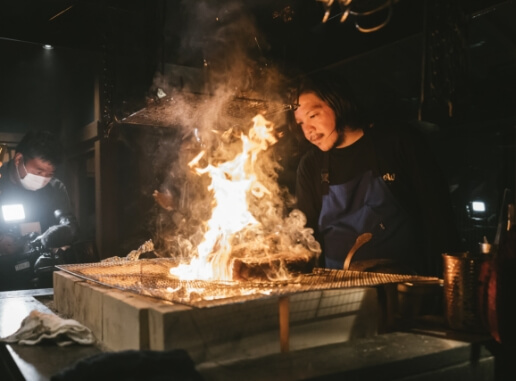

Embark on a journey into the heart of Aso's expansive grasslands, home to the revered Akaushi cattle. This adventure not only allows you to explore the environment where these rare cattle thrive but also to connect with the legacy and passion of those who have safeguarded them through generations.
Terroir, denoting the unique characteristics of the land, traditionally explains the varied flavors of wine due to its natural surroundings. By visiting and experiencing the climate, terrain, and ambiance firsthand, you embark on a true terroir journey. Are you ready to discover and savor the unique allure of Aso's Akaushi beef?
On Aso's expansive grasslands roam the Akaushi, a breed of Wagyu cattle with a characteristic reddish-brown coat. Thriving stress-free in nature, Akaushi are packed with high-quality nutrients. Their diet leads to an impressive profile rich in amino acids like taurine, proteins, vitamins B1 and B2, iron, calcium, and various minerals.
With its leaner composition, Akaushi beef strikes a perfect balance between delicate marbling and robust red meat, a hallmark of the brown Wagyu variety. While the black Wagyu is famed for its succulent fat, Akaushi allows connoisseurs to savor the authentic taste of beef with less fat, offering a healthier option that's increasingly favored by those mindful of their health.

The expansive, picturesque grasslands of Aso, chronicled in Japan's oldest historical records, the "Nihon Shoki," from 1300 years ago, have earned the moniker "Millennium Grasslands." Grazing cattle on these lands is not just a traditional practice but a vital one for sustaining this ancient ecosystem. By feeding on the mature grass, cattle play a crucial role in encouraging the growth of new grass.
While Akaushi cattle have been a cornerstone of Aso's agricultural heritage, the decline in farmers willing to take up this demanding work has led to a decrease in their numbers. In recent years, the trend has shifted towards beef cattle raised on grain in feedlots, a method that contrasts sharply with the more labor-intensive care required by Akaushi, including grazing and feeding on pasture. This shift has rendered Akaushi an increasingly rare presence in Japan's culinary landscape.
From spring through fall, Akaushi cattle are grazed on grasslands, thriving on the nutrient-rich pastures and wild grasses. Grazing in the grasslands allows Akaushi cattle to grow robustly in a free environment, developing strong limbs and overall better health. These cattle, capable of navigating steep valleys and areas inaccessible to humans and machinery, roam freely, grazing across the grasslands. With over 70% of these grasslands inaccessible by tractor, maintaining them through cattle grazing is essential.
The vast grasslands of Aso have been preserved over long periods through human intervention, such as the grazing of cattle and horses.
On the Akaushi Terroir Journey in Aso, we offer "Aso Sustainable Beef," a selection of Akaushi cattle that meet our sustainability criteria.
For more details, click here.
Three Key Aspects of the Aso Akaushi Terroir Journey
Normally, public access to the grasslands is restricted. On this tour, you have the unique opportunity to be up close with Akaushi cattle on usually inaccessible areas of grassland. You'll hear stories about Aso's history and the "Millennium Grasslands," directly from the members of the Pasture Association who manage these lands. Discover the roots of the grasslands that have been preserved through human efforts over centuries, and the cherished Akaushi cattle raised there. Tasting the exquisite Akaushi beef becomes an even richer experience when you understand the background and environment they come from.
On this tour, while gazing at the mountains of the Aso Caldera, you'll have the chance to gallop through the expansive grasslands on a genuine horseback riding adventure. Riding an E-MTB (electric assist mountain bike) lets you immerse in nature in a way that's uniquely intimate and exhilarating, feeling the landscape's vastness with every pedal. As you meander through the grand grasslands, watching cattle graze at their leisure, you're invited into a realm far removed from the everyday. Special access is also granted to usually restricted areas for a grassland BBQ experience. Enjoying a barbecue in the heart of the grasslands enhances the deep, rich taste of Akaushi beef like nothing else.
In addition to a grassland BBQ, this tour offers the chance to enjoy “Fire-Grilled Aso Akaushi Beef with Blazing Susuki Silvergrass”, as well as other traditional Aso dishes like charcoal-grilled delights and Dengaku (skewered and grilled food) at the hearth of a historic farmhouse. We've also arranged for a special Akaushi beef course meal available exclusively on this journey at a restaurant in Kumamoto City. After learning about Aso's history and connecting with its natural beauty, what better way to complete your experience than by savoring Akaushi beef through culinary delights? An unparalleled dining experience awaits you.

Experience an outdoor dining setup reserved just for you in the "Millennium Grasslands," a place usually off-limits to visitors. Delight in the rare opportunity to taste Aso's Akaushi beef through a gourmet BBQ and savor traditional Dengaku cuisine, all while surrounded by the grasslands' natural bounty. As a special memento, you'll receive a picture book that brings to life the ancient grasslands of Aso, sharing their secrets and significance through the ages.

Begin your adventure at the Aso Grassland Conservation Center with a brief introduction to Aso, followed by a guided tour through pastoral fields usually closed to the public. This experience will enrich your understanding of the relationship between Akaushi cattle and grassland conservation.
Dinner on the first day will be at the lodging “Aso Yamaboushi”. The main dish, "Fire-Grilled Aso Akaushi Beef with Blazing Susuki Silvergrass," lets you savor various cuts of Akaushi beef in a course meal designed for your enjoyment.
The second day features a horseback riding experience through the grazing lands of Akaushi cattle. This tour offers a unique opportunity to "learn, experience, and taste" the journey across the Millennium Grasslands.

Enjoy special access to pasturing areas typically off-limits, where you'll be introduced to the lesser-known origins of Akaushi cattle. Then, you'll partake in a grassland BBQ experience at a specially prepared site. The main dish, featuring The main dish is “Fire-Grilled Aso Akaushi Beef with Blazing Susuki Silvergrass”.
The vast grasslands nurturing Akaushi cattle have been preserved through centuries of human intervention, including grazing and controlled burns. However, traditional methods alone are becoming insufficient to maintain these grasslands.
To ensure the stable production of Akaushi cattle and the preservation of Aso's grasslands, the Aso Akaushi Terroir Journey collaborates with producers who adhere strictly to specified environmental and cattle-rearing practices. All Akaushi beef provided on our tours meet the selection criteria devised for this tour by Aso City, and is proudly presented as "Aso Sustainable Beef”.


environment
Are the cattle grazed on unimproved grasslands (wild grasslands), preserving grasslands with high biodiversity where a rich variety of life flourishes?

environment
Are the grasslands where Akaushi cattle graze conducting annual controlled burns, contributing to carbon accumulation in the soil?

environment
Are barns where the Akaushi cattle are housed when not grazing, properly equipped with effective waste management systems to prevent pollution of local groundwater and rivers?

society
Are the cattle raised in conditions where they are free from hunger and thirst?

society
Are calves allowed to graze with their mothers (parent-child grazing), spending time together in an environment free from stress and disease?

economy
Is locally sourced feed utilized, including wild grass harvested from local grasslands and feed harvested from local fields?

economy
Is information about the breeding history of Akaushi cattle (including provenance, feeding, antibiotic administration, etc.) appropriately disclosed and communicated?

economy
Are the profits obtained from the sale of Akaushi cattle fairly redistributed to the producers, rather than being monopolized by distributors?